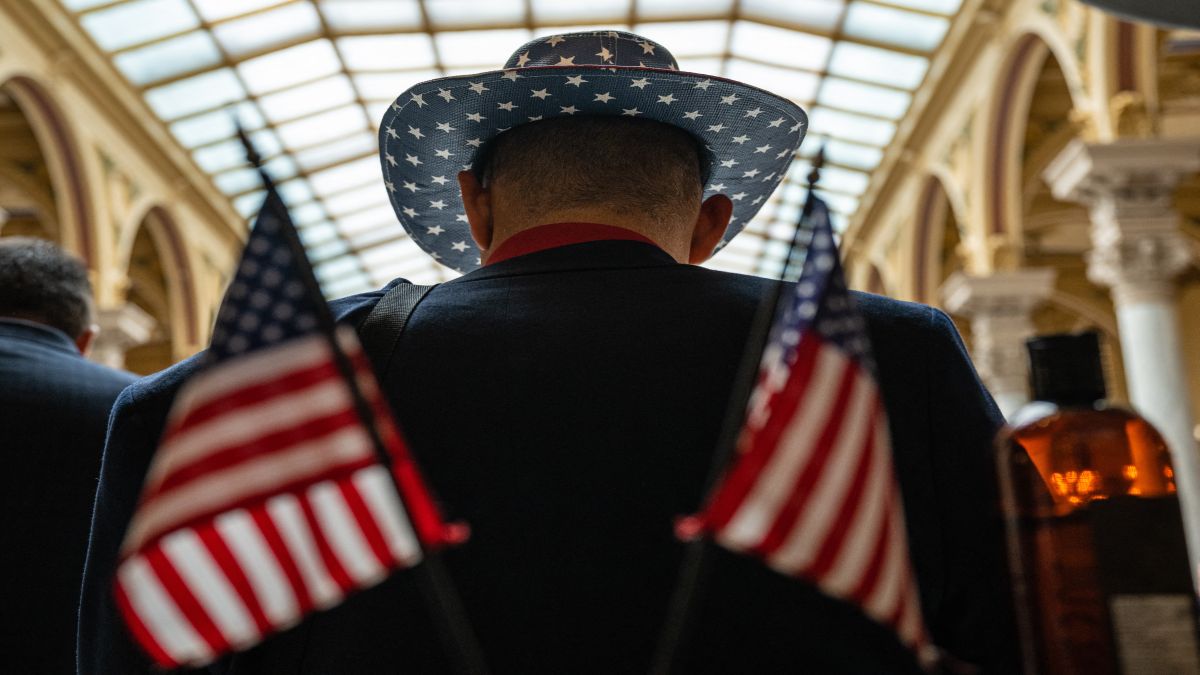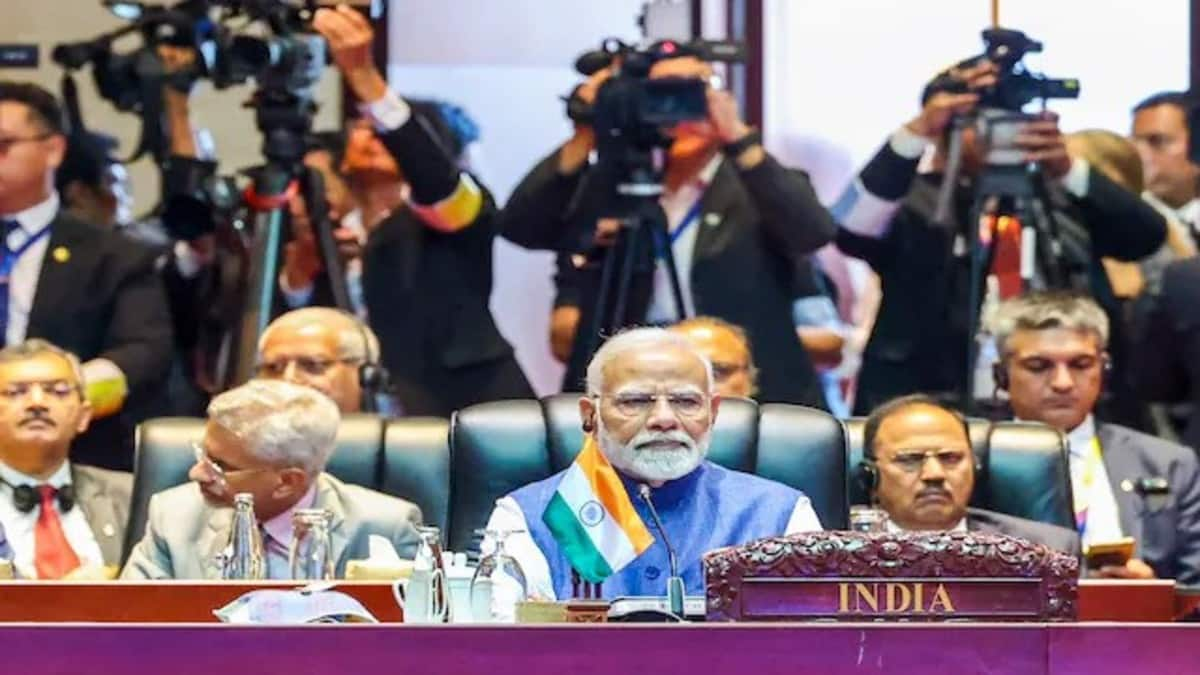anirvedah śriyo ṃūlam anirvedaḥ paraṃ sukhaṃ
anirvedaḥ hi satataṁ sarvārtheṣu pravartakaḥ
“Enthusiasm is the cause of success. It leads to great happiness. Enthusiasm indeed is what motivates in all endeavors.”
-Sundara Kanda, Ramayana
The recent increase in American hostilities against Indians and India, from racist anti-Hindu online rampages to official US government policies and positions on issues like H1B visas, tariffs, Pakistan, and blame for the Russia-Ukraine war, may mark the end of the 2024 conservative coalition which brought together under the inspiring slogan of ‘Making America Great Again’ (Maga) not only traditional Trump supporters from the white working class and Christian conservatives, but also many immigrants of colour, including some Muslim and Hindu Americans as well.
Much of the rhetoric before the elections was centred on an “inclusive” ideal of American greatness: a return to meritocracy, law and order, and “fairness” most of all. As if to underscore this message, the Trump-Vance campaign also had an impressive set of voices from across the religious, ethnic, and even ideological spectrum. Hindu anti-war ex-Democrat Tulsi Gabbard and business wonder and author from Ohio, Vivek Ramaswamy, were particularly of interest to Indian Americans.
From Maga to Miga (Make Indians Go Away)
All that seems firmly in the past now, for now at least. “Miga”, or “Make Indians Go Away”, seems to have become the mood of the day.
The present downturn has been the subject of many commentaries. Some blame the Indian government and urge compliance with US demands. Some in India, mostly TV show hosts and some panellists, blame the current US government and Maga for economic envy about Bharat’s rising world power stature under the current leadership.
There is also an increasing focus in Indian media on the role (or lack thereof) of the Indian diaspora in “lobbying” US policies towards India. Shashi Tharoor, for example, recently said that some American politicians revealed that no Indian-American constituents had reached out to them about the tariffs. Social media is rife with disappointments about the once storied Indian-American CEOs, as well as brave admonitions to Indians to use the setback as an opportunity to make India’s tech economy strong instead. Criticism of American racism and religious bias against Hinduism is also going around with some intensity (illustrated, most recently, by a Texas Republican’s rude comments on a Hanuman statue).
Impact Shorts
More ShortsTo understand why all of this happened, the present article argues for a simpler, more direct explanation (not necessarily excluding some of the issues discussed by others above). The short answer is: because they can. America has normalised certain tropes, beliefs, and myths about Indians, India, and Hinduism so widely and deeply everywhere that only an industrial-strength exercise of imagination, creativity, and knowledge can snap us out of it. It started as “because they can”, and it will soon become “because you must”.
Seeing the Social Engineering Blueprint Clearly
That is how propaganda, social engineering, compliance, coercion, and the “Ministry of Truth” work. Indians have survived as a civilisation longer than anyone else, perhaps against propaganda, but have not bothered to direct their attention to the question of how a propaganda society works. We adjust to it when we enter, yes, but when we fail to see how much we are asked to “adjust” to and “adjust” into, and when we can clearly see that difference in the peer pressure and behavioural-ideological compliance pressure that the next generation faces in schools, colleges, and workplaces, we have to know. This is the future. This is the present. This is the past of their societies we didn’t really ever have to see or face until we started to live deeply in them. Their society’s condition, one of ever-painful compliance, will be our future too, unless there is a change in understanding and, of course, action.
The first shift in understanding needed pertains to the disciplinary or conceptual approach to the problem.
Most of the “important” commentators tend to focus on geo-economics and politics. These approaches carry heft. Or sound that way, at least. But time and again, these domains have frankly proved to be downwind, or downstream, as the saying goes, of the seemingly light-sounding, frivolous topic of culture. In both American and Indian politics, we have seen the “cultural” dominate the political. And in terms of “left-right” locations, it is the sheer brilliance of the “left” in this domain that prevails, no matter how “right” a party in power wishes to be.
In India, the language established for Indian social history by the Left remains the language of politics: “thousands of years of Brahminical denial of drinking water and education” and similar tropes. In America, the Right, or the conservatives in general, have had a long history of investment in education too and were quite dominant all the way through the Reagan era in the 1980s (unlike in India), but since the 2000s, universities, arts, media, and even corporates have seen a shift towards liberal positions. The current leadership is clearly determined to dethrone this dominance through massive funding cuts and public campaigns (like the late Charlie Kirk’s influential campus outreach programmes). But until they got elected, even the Maga alliance remained respectful of the broader “liberal” definitions of inclusiveness and tolerance, at least on race and legal immigration.
Post-elections, there appear to be divisions and discord within this world, with the phrase “Woke Right” catching on as a way to criticise more tribalist elements among the conservatives. But whatever their struggles for definition and nationhood might be, for now, Indians and Hindus have proved firmly unable to escape the converging crosshairs of hate and blame made by both the left and the right.
Culture and Its Processes
The second shift in understanding necessary is to recognise that culture is a product, yes, but not everyone has experience and experience in shaping it equally. In many ways, Indian Americans, and the Indian government, frankly, are getting what it paid for. Because most Indians tend to be in management, business, or STEM, they are used to engaging with media, journalism, and culture as only consumers (or as private social media personalities at best). They have not built “cultural” products with their hands and have little practical conception of the whole “assembly line” of cultural and ideological production, of organised mass persuasion, as it were.
There may be Indians managing media, or even owning media, sure. They can read profit and loss statements, sure. But they cannot read the “tea leaves”, the signs and misdirections, the cues and hints that have been building up for years and years across institutions and platforms now, schools, colleges, think tanks, NGOs, magazines, and movie studios in the US and India and elsewhere, of cultural or definitional supremacy over India and its supposedly resurgent one billion Hindus. We don’t realise that institutions with ideological clarity about the moral or religious necessity for your extinction will prevail over our mere clicks, likes and even votes in the election.
Running influence campaigns for elections in your home country is different from defeating an existentially threatening psy-op against your people living, even if in some economic comfort for now, in another country.
The third point to appreciate about the cultural product we are dealing with here is that it’s not simply a flawed, mistaken, or even mischievous misrepresentation of who you are by the host country’s institutions and public discourse. It is a whole system that has been running quite efficiently for them. That system has a purpose. It is to achieve control over society. That system has not just political, economic, or technological dimensions, but also narrative, aesthetic, emotional, ideological, and persuasive ones.
Martyrs, Heretics, and Devils
Indians, who are usually clever about figuring out how to get by wherever their jobs take them on earth, haven’t bothered learning about the stories by which others live. The basic storyline of their civilisation for almost two millennia has been simple and quite different from ours (call it sanatani, dharmic, Hindu, or pagan, or whatever you will).
In their foundational social stories, there are always good people and bad people. There is usually a prophet and/or a martyr to inspire and lead the good people. There is usually an evil leader or false prophet to lead the bad people. You can see it in various moments in their history and in their conflicts, whether between religions or within the same religions (when “heretics” usually replace the “pagans” or “kafirs” as the “bad people”).
This story structure has been depicted by great writers again and again in various forms. In George Orwell’s 1984, the despised opposition leader is Goldstein. In real life, the Goldstein stereotype has been used by propagandists for a cast of characters: communists, third-world dictators, and leaders of countries they wish to bring “democracy and human rights” to.
Indians have to understand that whatever it is we think of ourselves (model minorities, good immigrants, believers in fair play and meritocracy and education, largely non-criminal), our image has been deeply recast by organised story-telling along certain lines.
We may not fit their model of an enemy or worthy enemy (absolutists enjoy warring usually with others like them). Nor do we fit in the image they were offered of us before as largely pitiable, “third world” heathens in need of “saving” or at least “developing”. In our minds, we are free-market competitors, following not even our rules, but theirs. But in their stories, we will be different. We have been worked on to appear different.
The fourth point to recognise about the process of propaganda is that this story is not seen by the forces and organisations that drive it simply as just another story to be casually consumed. It achieves synergy through repetition across platforms and variations. But it also adapts, ever so slightly, to time and place. In our media classes we discuss the eugenics mania and anti-immigration campaigns of the 1920s.
Katherine Mayo’s book Mother India was a perfect fit for that time, with all her rants about the Hindus’ “bankrupt stock” and fear-mongering over disease. In the 2020s, no one talks about the Hindu’s genes. But otherwise, the same tropes are still at play now, about hygiene, corruption, false gods, and being a burden to the civilised world. The racial-religious hierarchy in Mayo’s scheme also hasn’t changed much; for her, Hindus were at the bottom, below “Mohammedans” and the “Anglo-Saxon Protestant” in his “glory”.
She even swapped the identities of Muslims and Hindus while writing about a real-life Indian murderer to make it seem that a Hindu had killed Muslims when it was the other way around. In the 2020s, reporting about riots and terrorist attacks follows the same, or at least a similar, playbook. Slumdog Millionaire was a fictional work, sure. But its powerful scene showing Hindus yelling “They’re Muslims” and killing Jamal’s mother, a blue-painted boy looking like Rama appearing, and other tactics were also reflected in the news and opinion pages around the time of the 26/11 attacks.
Attention Trumps Agreement
The fifth point is to remember that attention trumps agreement. In persuasion campaigns, and sadly, even journalism and higher education, which ought to have stayed clear of such cheap commodification and co-optation, have become complicit now; there is no need to bother about credibility, evidence, and other niceties of old epistemology. There is only shock and stun and awe, and then move on. To give an example from the US election days, it was like the meme about “eating the dogs and cats in Springfield”. An animal lover made a nice song about it and donated money to charities. Otherwise, it was nothing nice or verifiable at all. The President’s allegation about pet-eating illegal immigrants became a thing to feed minds and words on; some believed it (and worse), others laughed at its absurdity and racial hostility.
Now, Indians haven’t been accused of eating dogs and cats, but the nails that have been hammered into them by association have been worse. We say this because while the claims have lacked credibility, the institutions in which they were made are not inconsequential ones. For the past ten years or so, the limits of what is considered acceptable to be said publicly about Indians, Hinduism, and India have been getting stretched carefully and deliberately.
In the same period, American public discourse had actually become even more careful about what could be said or not said about different minorities or immigrant groups. Yet, India, Indians, and especially Hindus, really got elevated into a special status altogether, a kind of “MFN” label, but in reverse (not “Most Favoured Nation” but “Maliciously Fib-about-able Nation”).
Maliciously Fib-about-able Nation
When it came to Indians and India, people in positions of authority (and not just online trolls) could say whatever they wanted, true or false, and get away with it without consequence to status, reputation, or profession. For example, newspapers could print screaming headlines alleging that India is stripping 200 million Muslims of citizenship. Professors (in the UK at that) could tweet demanding that the US government cancel H1B visas in retaliation to that non-policy.
In some other context, professors of history could concoct lines that didn’t even exist in Valmiki’s Ramayana to say Sita called Rama a “misogynistic pig”. And of course, politicians like New York’s mayoral aspirant Zohran Mamdani could make up the totally fact-free claim that there are no Muslims left in Gujarat since the “pogrom” of 2002.
This was not a normal situation by any standard (except for the politician part perhaps, since they are, as a class, attention-grabbers). Through sheer power of pelf and privilege (and persuasion-magic), they normalised the lie. The nastier and crazier the lie, the better it was.
Remember the allegations about Georgia gynaecologist Mahendra Amin, who was said to be mass sterilising poor immigrant women like Joseph Mengele and smeared as a “uterus collector” (he later sued for defamation)? Or the more recent unfounded headline campaign in a leading Indian newspaper which claimed that pregnant Indians on temporary visas in the USA were paying American doctors to perform premature C-section deliveries to circumvent any changes in birthright citizenship laws? Maybe this was the kind of credible and professional news that well-meaning (surely) foreign aid to help train Indian journalists in fighting “fake news” has been producing!
To be continued in the second part…
Vamsee Juluri is Professor of Media Studies, University of San Francisco. He has authored several books, including ‘Rearming Hinduism: Nature, Hinduphobia and the Return of Indian Intelligence’ (Westland, 2015). C Raghothama Rao is a writer, podcaster and YouTuber. The views expressed in the above piece are personal and solely those of the authors. They do not necessarily reflect Firstpost’s views.


)

)
)
)
)
)
)
)
)



